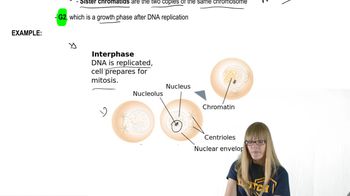Table of contents
- 1. Introduction to Genetics51m
- 2. Mendel's Laws of Inheritance3h 37m
- 3. Extensions to Mendelian Inheritance2h 41m
- 4. Genetic Mapping and Linkage2h 28m
- 5. Genetics of Bacteria and Viruses1h 21m
- 6. Chromosomal Variation1h 48m
- 7. DNA and Chromosome Structure56m
- 8. DNA Replication1h 10m
- 9. Mitosis and Meiosis1h 34m
- 10. Transcription1h 0m
- 11. Translation58m
- 12. Gene Regulation in Prokaryotes1h 19m
- 13. Gene Regulation in Eukaryotes44m
- 14. Genetic Control of Development44m
- 15. Genomes and Genomics1h 50m
- 16. Transposable Elements47m
- 17. Mutation, Repair, and Recombination1h 6m
- 18. Molecular Genetic Tools19m
- 19. Cancer Genetics29m
- 20. Quantitative Genetics1h 26m
- 21. Population Genetics50m
- 22. Evolutionary Genetics29m
9. Mitosis and Meiosis
Mitosis
Problem 30b
Textbook Question
Textbook QuestionDrosophila has a diploid chromosome number of 2n = 8, which includes one pair of sex chromosomes (XX in females and XY in males) and three pairs of autosomes. Consider a Drosophila male that has a copy of the A₁ allele on its X chromosome (the Y chromosome is the homolog) and is heterozygous for alleles B₁ and B₂, C₁ and C₂, and D₁ and D₂ of genes that are each on a different autosomal pair. In the diagrams requested below, indicate the alleles carried on each chromosome and sister chromatid. Assume that no crossover occurs between homologous chromosomes.
For the metaphase I alignment shown in (c), what gamete genotypes are produced at the end of meiosis?
 Verified Solution
Verified SolutionThis video solution was recommended by our tutors as helpful for the problem above
Video duration:
2mPlay a video:
408
views
Was this helpful?
Related Videos
Related Practice
Showing 1 of 2 videos


